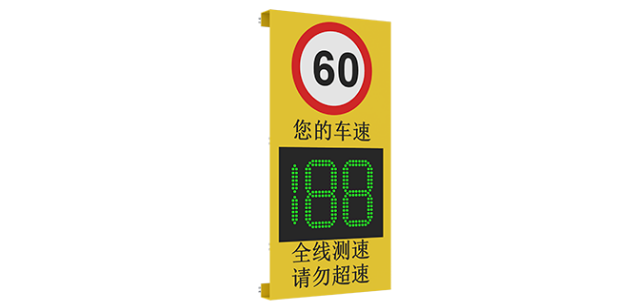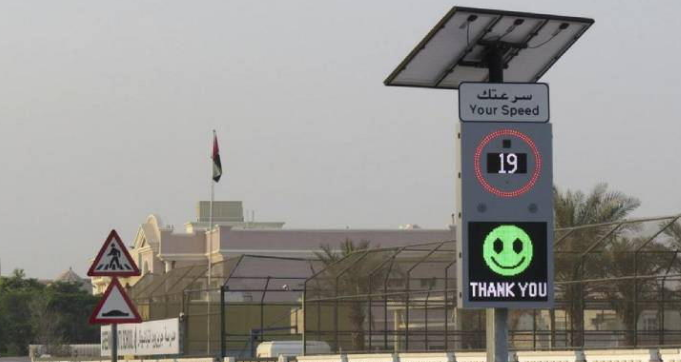Una guía detallada de las señales de velocidad de radar
Las señales de velocidad de radar son pantallas electrónicas que utilizan LED para mostrar la velocidad de los vehículos a medida que se acercan los conductores. Por lo general, compuestas por varios LED, estas señales notifican activamente a los conductores si exceden el límite de velocidad especificado, animándolos a desacelerar. Las señales de velocidad por radar, que funcionan como parte de medidas para calmar el tráfico, complementan o sustituyen las señales de límite de velocidad y las marcas viales tradicionales, contribuyendo eficazmente a la regulación de la velocidad de los vehículos para lograr carreteras más seguras.
¿Cómo funcionan las señales de velocidad por radar?
Las señales de velocidad de radar funcionan en función de las señales transmitidas. Estas señales emiten señales inalámbricas y se centran en detectar las comunicaciones inalámbricas emitidas por vehículos en movimiento.
El proceso consiste en medir la diferencia de tiempo entre la transmisión y la recepción de la señal por parte de las señales de velocidad del radar. Este diferencial de tiempo determina la distancia entre la señal y el vehículo. A medida que el vehículo se acerca o se aleja de la señal, la distancia cambia. Al utilizar estas distancias variadas y las velocidades mostradas en la señal, la velocidad del vehículo se calcula con precisión.
Estos dispositivos se pueden programar para establecer un límite mínimo de velocidad, activando una alerta si un vehículo supera este umbral. Algunos vehículos también están equipados con señales de detección de velocidad, que se encuentran comúnmente en vehículos policiales o vehículos de control de tránsito.
Las señales de velocidad con radar sirven como herramientas invaluables, ya que ayudan a las autoridades de tránsito a hacer cumplir la ley y, al mismo tiempo, ayudan a los conductores a respetar los límites de velocidad. Son cada vez más esenciales en áreas críticas o de mucho tráfico, como escuelas, áreas residenciales, hospitales y otros lugares importantes.
Aplicaciones de las señales de velocidad por radar:
Gestión de intersecciones:
En los principales cruces de tráfico de las ciudades, el caos durante las horas pico es algo común. Las señales de velocidad con radar ofrecen una solución eficaz para reducir la congestión y los atascos en las ciudades modernas. Los sistemas de radar avanzados proporcionan información del tráfico en tiempo real, monitorean la distancia y la velocidad del vehículo y al mismo tiempo guían a todos los usuarios de la carretera hacia rutas apropiadas para aliviar la congestión.
Gestión de vías arteriales:
La colocación de una señal de velocidad por radar en las vías arteriales monitorea de manera efectiva las secciones de varios carriles, lo que es especialmente beneficioso para autopistas o vías con mucho tráfico. Estas señales reducen significativamente el riesgo de accidentes al ofrecer actualizaciones de tráfico en tiempo real e identificar a los conductores que exceden la velocidad. Al funcionar perfectamente en diversas condiciones climáticas y de iluminación, resultan muy eficaces en túneles y áreas con exposición directa a la luz solar.
Aplicación:
Abordar los problemas relacionados con el tráfico debido a la falta de personal es un desafío frecuente en las carreteras indias. Las señales de velocidad con radar ofrecen un alto grado de precisión y confiabilidad en la gestión del tráfico. Estas señales ayudan a detectar a los conductores que exceden la velocidad, mejorando las medidas de cumplimiento. Colocar esta tecnología en cruces o en carreteras ayuda a atrapar a los infractores que infringen semáforos en rojo, conducen en sentido contrario u otras acciones ilegales.
Tecnología de radar para aplicaciones de tráfico:
Actualmente, existen cuatro tipos distintos de tecnologías de señales de velocidad por radar según sus capacidades de radar:
1. Radar 1D: Mide solo la velocidad del vehículo sin ubicación de objetos, enfocándose en el tráfico unidireccional.
2. Radar 2D: detecta velocidad y alcance sin localizar objetos a distancia.
3. Radar 3D: identifica objetos en un entorno 2D analizando la velocidad, el alcance y el ángulo de movimiento de vehículos y usuarios.
4. Radar 4D: comprueba la velocidad, el alcance, el ángulo y la elevación, proporcionando una localización precisa de los objetos en un entorno 3D.
Estas variaciones en la tecnología de radar se adaptan a diferentes escenarios de tráfico, mejorando la capacidad de monitorear y gestionar las carreteras de manera efectiva.
Ventajas de utilizar señales de velocidad de radar para el control de velocidad:
Las señales de velocidad con radar ofrecen varias ventajas notables, entre las que destaca su eficacia para frenar las conductas de exceso de velocidad. Las investigaciones han demostrado consistentemente que los conductores tienden a desacelerar al ver su velocidad destacada en estas señales. Este ajuste de comportamiento contribuye significativamente a mejorar la seguridad vial y mitigar la probabilidad de accidentes.
Además, las señales de velocidad por radar cuentan con procesos de instalación y mantenimiento sencillos, lo que aumenta su atractivo como solución de control de velocidad. Son programables, lo que permite la visualización de mensajes variados según la hora del día o los requisitos específicos del área. Esta adaptabilidad garantiza su idoneidad para abordar de manera eficiente diversas necesidades de gestión de la velocidad.
Desventajas de utilizar señales de velocidad por radar para controlar la velocidad
A pesar de las numerosas ventajas que ofrecen las señales de velocidad por radar para el control de la velocidad , existen varios inconvenientes potenciales que merecen consideración. Una preocupación principal es el riesgo de que los conductores confíen demasiado en estas señales, pasando potencialmente por alto factores cruciales como las condiciones de la carretera o la presencia de peatones. Además, existe la posibilidad de que algunos conductores ignoren las señales por completo o, peor aún, las vean como un desafío para probar sus límites de velocidad. Por último, el costo de comprar y mantener señales de velocidad por radar podría representar un obstáculo financiero para ciertas comunidades u organizaciones, haciendo menos factible su implementación.
Alternativas a las señales de velocidad por radar para el control de velocidad.
Existen enfoques alternativos para el control de velocidad además de las señales de velocidad por radar, cada uno de los cuales ofrece su propio conjunto de ventajas e inconvenientes. Métodos como badenes, rotondas y rotondas sirven como alternativas viables. La eficacia de cada método depende de las condiciones únicas de la carretera y del tráfico. Por ejemplo, los badenes podrían reducir eficazmente la velocidad en calles residenciales, mientras que las rotondas podrían ser más adecuadas para gestionar el tráfico en intersecciones muy transitadas. Una consideración cuidadosa de estas opciones es crucial para determinar el enfoque más adecuado para una situación específica.










Deja un comentario